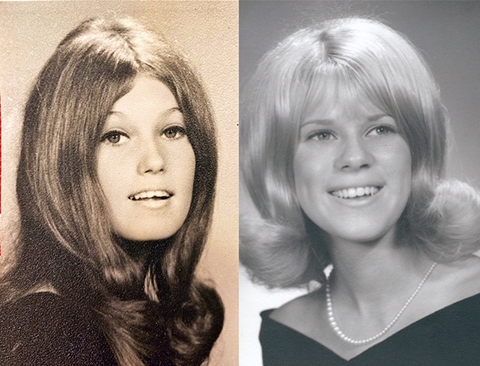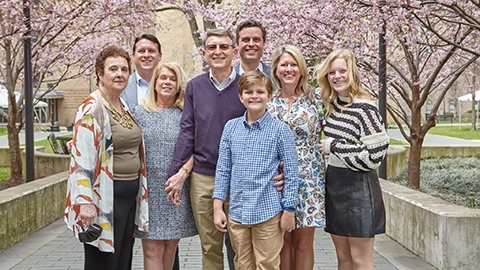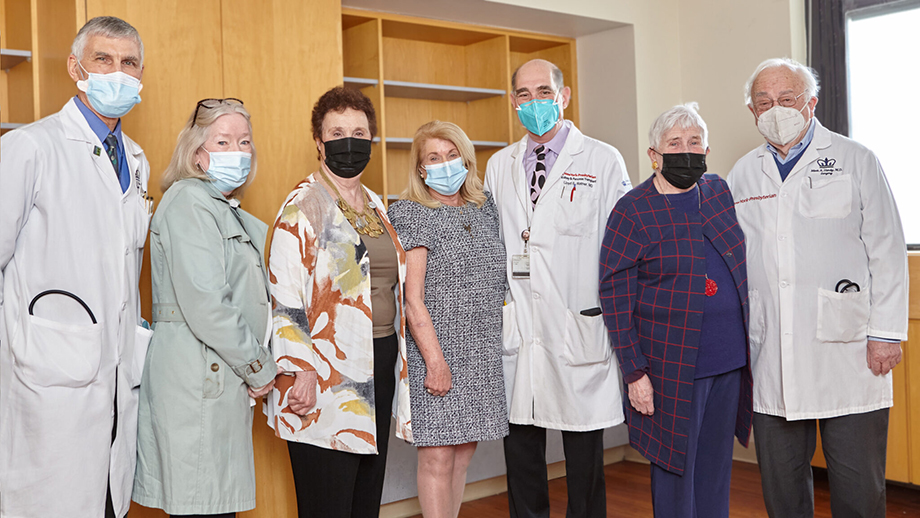By Elisabeth Geier
In 1971, at age 22, Jennifer Embree Rudeman donated a kidney to her sister Melinda Embree. 50 years later, in 2021, she reached out to NewYork-Presbyterian/Columbia University Irving Medical Center to plan a visit commemorating the 50th anniversary of the two operations that changed her family’s life. Her call was answered by Brian Runge, Chief Living Donor Nurse Coordinator for the renal transplant program.
“She just randomly called…and wanted to come up and see how things have changed,” remembers Brian. Jennifer eventually visited the hospital in April 2022, a special reunion you can read about on NYP’s blog Health Matters. In the spirit of Jennifer’s visit, we followed up with Brian and Lloyd Ratner, MD, Director of Renal and Pancreatic Transplantation at NYP/CUIMC, to learn more about what the living donation process looks like today, and how living donation impacts donors, recipients, and their families.
There are two types of living kidney donations: non-directed and directed. In a non-directed donation, donors will step forward to donate a kidney without knowing where it’s going. In directed donations like Jennifer’s, donors give their kidney to somebody they know–most often a close family member in need of a transplant.
 Jennifer and her sister were lucky to be a match back in 1971, but a lot has changed in the 51 years since Melinda’s transplant. Brian works with all of the living donors for kidney transplant who come to the center, walking them through the donation process from start to finish: a full medical work-up, testing for compatibility, and coordinating care once a match is identified. As a transplant nurse coordinator for almost 15 years, he’s seen the process get easier and easier for donors.
Jennifer and her sister were lucky to be a match back in 1971, but a lot has changed in the 51 years since Melinda’s transplant. Brian works with all of the living donors for kidney transplant who come to the center, walking them through the donation process from start to finish: a full medical work-up, testing for compatibility, and coordinating care once a match is identified. As a transplant nurse coordinator for almost 15 years, he’s seen the process get easier and easier for donors.
For one thing, the surgery and recovery process have improved. As Brian puts it, “Who wants to have surgery back in the day, in the 70s and 80s? Cut yourself halfway open from side to back, remove a rib and take a kidney out and be in the hospital for weeks on end with a huge amount of pain and a high chance of post-donation complications?”
The process itself transformed in 1995 when Dr. Ratner pioneered the laparoscopic donor nephrectomy. Reducing the procedure to a three-hour, minimally invasive surgery requiring one or two nights in the hospital and full recovery within a few weeks.
Along with a much easier surgical process for donors came improved success rates for recipients. The results of transplantation are utterly transformative in comparison to the survival statistics from 50 years ago. In 1971, there was a 50 percent chance a donated kidney would last a year—making it truly incredible that Melinda Embree thrived for 16 years after receiving Jennifer’s kidney.
These days, “something like 97 percent of people from a live donor transplant will be alive and have the kidney functioning one year later,” Dr. Ratner says. “We’re seeing patients who are more than 20, 30, even 40 years out from their transplants."
For kidney recipients, the benefits of donation are clear: improved health and a second chance at life. But the impact of donation can last a lifetime for donors, as well.
Choosing to donate is “all voluntary, and there can't be any donor pressure or coercion from us,” says Brian. But he does like to tell prospective donors the potential benefits of choosing to be a donor: “First I tell them, ‘you get a million dollar workup.’ There's no medical risk to you.” Donors undergo various health tests to ensure they’re fit to donate, and all it costs them is their time and a few vials of blood. “The only risk is us finding something you didn't know you had…and that's a good thing,” explains Brian.
He recalls the time a workup revealed previously-undetected lung cancer in a prospective donor. She was able to undergo treatment and her cancer went into remission; and her son eventually received a transplant from a different donor. However, stories like this are rare–most donors are healthy and make it through the workup without issue. “Our complication rate is zero,” says Brian.
Of course, the surgery experience is unique to the individual. “Everybody's different with pain [and] everybody's different with how their body handles it afterwards,” he says. “But for 99.9 percent of the donors, they don't have issues.”
The emotional impact of being a kidney donor lasts longer than any post-procedure discomfort. Brian says he sees more directed kidney donations than non-directed these days, most often between family members who share a special bond. Sometimes, people try to keep it a secret for a while too. Brian recently worked with a young woman who started the process not wanting her dad to know that she was pursuing donation until after she was fully cleared. But more often, families begin the process together, and recipients know who their donor is from day one.
It’s not always so simple: sometimes intended direct donations aren’t a match. In the past, that meant going back into the general transplant queue and crossing your fingers. But these days, “donor swaps” and “donation chains” make it possible for more people than ever to get kidney transplants.
When living donors and their intended recipients aren’t compatible, they can enter the Alliance for Prepared Kidney Donation (APKD), a national program that helps locate donor matches, and receive donations from an incompatible match somewhere else. “My donor will donate to you, your donor will donate to me, and each donor is helping out their intended recipient by giving up a kidney,” explains Brian. “We just got a kidney from Michigan.”
If this all sounds a bit complicated, well, that’s because it is. Kidney donation surgery has been refined for decades, with the team at Columbia continuously at the forefront. But there’s still a lot of behind-the-scenes work to coordinate surgery, educate and prepare donors for the transplant process, whether they’re donating to a loved one or a stranger. That’s where nurse coordinators like Brian become indispensable.
As the main point of contact for patients navigating the donation process, Brian and other nurse coordinators develop relationships that rely on clear communication, kindness, and diplomacy. Their goal is to be kind and caring while providing medical care, fielding questions, and navigating sometimes fraught communication between donors, recipients, and family members.
“I always say, your coordinator is your best friend with transplant,” Brian says. “If you have questions, pick up the phone and call…we’ll tell you what the next step is.” In a medical system impacted by staffing shortages and the ongoing pandemic, it can be a stressful role. But despite the challenges, Brian has stayed in transplant coordination for almost 15 years, the first 11 on the recipient side, and more recently on the donor side. The people he works with and their stories keep him motivated to show up for work every day.

Jennifer Ruderman’s story is evidence of the lasting impact of kidney donation. Her sister lived for 16 years beyond transplant, an utterly remarkable amount of time in those days. And 50 years after the fact, Jennifer brought her kids and grandkids to New York to reconnect with the transplant program that extended her sister’s life.
“Donating a kidney isn’t just something that happens to you once and then you move on,” says Dr. Ratner. “Jennifer is the hero of her family two generations on…the impact lasts for the rest of your life.”
If you or someone you care about is in need of a kidney transplant, Columbia Surgery can help. Call (212) 305-6469 to get started today, or sign up with one of our online forms: I Need A Transplant » | I Want to Donate My Kidney »

